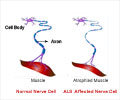Treatment and Management of Amyotrophic Lateral Sclerosis (ALS)
A specific cure for ALS does not exist, hence the treatment of the disease is focused on slowing the progression of the disease and making it manageable.
- Medications- Food and Drug Administration (FDA) has shown the green signal for the first drug riluzole (Rilutek) that can be used in the treatment of ALS. Riluzole works to minimize motor neuron damage by controlling the release of glutamate.
- Clinical trials with ALS patients showed that Riluzole does not reverse the damage already inflicted but mainly helps those with difficulty in swallowing. It also extends survival by several months and delays the need for ventilation support. However, there remains a possibility of developing some side effects (such as liver damage).
- Medications to control fatigue, muscle cramps & pain, constipation, excess salivation & phlegm, spasticity, depression and sleep disturbances are often prescribed for these patients.
- Physical therapy under the guidance of a physical therapist encourages the patient to do simple and low-impact exercises such as walking, swimming, or stationary bicycling. This increases muscle strength and improves cardiovascular health besides helping the patient to counter fatigue and depression.
- Occupational therapists can help the patient to become familiar with devices that would help them in daily life such as wheelchairs, walkers, ramps and braces that help patients to remain mobile and active to some extent.
- Speech therapy is recommended for ALS patients as communication becomes increasingly difficult with disease progression. Speech therapists can teach the patients how to speak more loudly and clearly and also to use non verbal means to communicate. They also help the patient to make the use of devices such as speech synthesizers and computers that make better communication possible.
- Caregivers of ALS patients must learn from nutritionists how to prepare small nutritious meals that can be given to the patient at various intervals throughout the day. If the patient can no longer eat, a feeding tube can be inserted into the stomach. This also helps to avoid choking or developing pneumonia.
- Suction devices are often used to remove excess fluid or saliva from the patient to prevent chocking.
- A nocturnal ventilatory assistance will be used to artificially inflate the lungs and aid breathing while sleeping. As the disease progresses the ventilator will be used full time.










